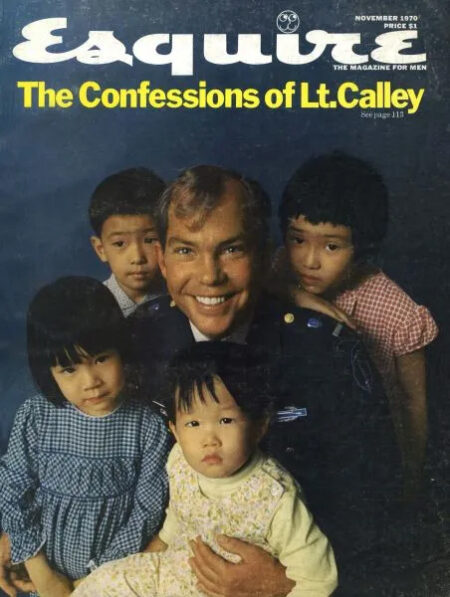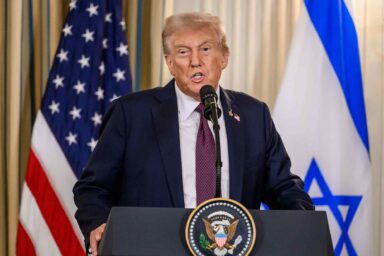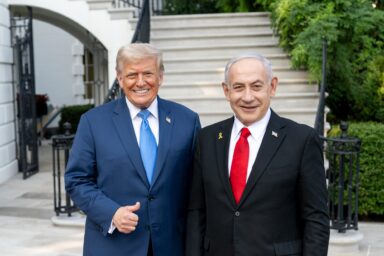Following orders himself, Calley ordered his platoon to kill over 500 Vietnamese villagers in My Lai in 1968. What was behind his ability to give that command?
|
Listen To This Story
|
I have a history with Lt. William “Rusty” Calley, whose death became known yesterday when it was discovered in a public record. It emerged that he had died in hospice at age 80 on April 28 of this year in Gainesville, FL, where he had lived since 2018.
It is somehow fitting that Calley’s death in obscurity went unnoticed by the media for three months. His story as the only Army officer convicted in the massacre of some 500 Vietnamese civilians at My Lai in 1968 had seemingly been forgotten, lost amid stories of much larger American war crimes, including the entire US war in Iraq, based on the lie that Saddam Hussein was hiding a stockpile of nuclear weapons and other WMD, weapons of mass destruction, that the Bush administration knew never existed. The Bush administration piled on another alleged crime to justify the war: that Saddam had had something to do with the terror attacks on the World Trade Center and the Pentagon, which was also a lie. Hundreds of thousands of Iraqis lost their lives during America’s horribly misbegotten adventure in Iraq, along with 4,500 American soldiers.
So, it’s tempting to say that Calley deserved the quiet ignominy of his lonely death in Florida. He was a war criminal, long a symbol of the evils of the war the US fought against the Vietnamese people for some 10 years that cost more than a million Vietnamese civilian casualties. At the time, anti-war protesters called the war in Vietnam a war crime, and over the years it has been adjudged to have been one — yet another American war fought on the basis of yet another American lie.
But for a few years there, Calley was one of the biggest stories in US media, if not the world. The crime was horrific, with photographs published all over the world (warning: graphic images of war) of dead Vietnamese civilian bodies lying along a road where they were gunned down by Calley’s men on Calley’s orders as they tried to run away from the massacre that was underway in the tiny village of My Lai.
I first became aware of him in early September of 1969 when I ran into one of my West Point classmates at the Ft. Benning PX one day. We stopped to talk, and he told me a strange story: That morning, his roommate, a lieutenant by the name of Rusty Calley, had been arrested by the military police and taken away. He hadn’t seen the roommate since and didn’t know anything about why he had been arrested or what the Army had done with him. (The classmate, who had gotten his apartment share a month earlier from a bulletin board in the very PX where we stood, couldn’t afford the rent without splitting it and had to find another roommate that week.)
On November 13, Seymour Hersh published his famous series of articles exposing the My Lai massacre on the left-wing Dispatch News Service after having offered the story to The New York Times and other mainstream news outlets that were uninterested. Hersh’s revelations blew the lid off the story. Color photographs taken by a soldier found their way into the Cleveland Plain Dealer later that week.
The story was picked up by every major news outlet that had turned down Hersh’s story, including Time, Newsweek, and Life magazine. CBS ran an interview with a soldier who had been in Calley’s platoon and took part in the massacre. By November 21, Henry Kissinger was meeting with President Richard Nixon about how they were going to control the fallout from the story, which was undermining the US war effort and causing Nixon political problems.
On November 24, Lt. Gen. William R. Peers was appointed to form a task force to investigate the massacre and the Army’s part in its cover-up. His report, turned into the Pentagon in March of 1970, found that at least 200 civilians had been killed and criticized all the officers in higher commands in the Americal Division, to which Calley’s platoon belonged.
Calley had already been charged with killing civilians in September of 1969. Now the Army decided to charge 25 more soldiers in the massacre and its cover-up. Those charged included Maj. Gen. Samuel W. Koster, the commander of the Americal Division, who was found to have flown over the village of My Lai as Calley’s platoon first moved into the village and afterwards. As photos later showed, it would have been impossible not to have seen the hundreds of dead Vietnamese bodies that lay on the ground within the village and outside of it. Koster was charged with attempting to cover up the massacre as the division commander.
In an aside, Koster was the superintendent of West Point during my last year as a cadet in 1969. He attempted to dismiss me from the Academy only two days before I was scheduled to graduate because of my opposition to compulsory attendance at church while I was a cadet.
My formal complaints to the secretary of the Army and those of three of my classmates, all seeking to overturn the mandatory chapel rule at West Point, created huge problems for Koster and for Col. Alexander M. Haig, who was then deputy commandant at West Point. We were sentenced to walk punishment tours on the area between the barracks for seven hours a day during June Week, the celebratory week we had free before graduation. We walked with rifles on our shoulders two hours in the morning, three in the afternoon, and two at night starting at 7 p.m.
In his last address to the class of 1969, given in an auditorium just across the street from the barracks, Koster pointed from the stage in the direction of the area of barracks where we were walking punishment tours and included a warning to the class of “what happens to troublemakers in the Army.”
After Koster was charged in 1970 for his role in the My Lai massacre he was demoted to brigadier general, stripped of his Vietnam medals, and removed as superintendent. From my perch at The Village Voice, where I was by that time a staff writer, I wrote Koster a letter on Voice stationery consisting of a single sentence: “Who is the troublemaker in the Army now, Gen. Koster?” It was one of the most satisfying sentences I have ever written, before or since.
In another aside, compulsory attendance at church at the service academies was overturned by the DC Circuit Court of Appeals in 1972, a decision later upheld by the Supreme Court, which unanimously refused to hear the Pentagon’s appeal. The Department of the Army paperwork filed by me and my classmates in 1969 played a key role in the federal case against the secretary of defense, used as evidence that all so-called “administrative remedies” had been exhausted before one West Point cadet and six midshipmen from the Naval Academy filed suit to end compulsory attendance at church.
In yet another aside, Koster spent years trying to overturn the Army’s decision to demote him and strip him of his Vietnam medals. The lawyer he hired to represent him administratively in the fight with the Pentagon, and later in federal court, was my classmate and friend Richard Swick, one of the troublemakers who had pissed off Koster and walked the area with me and the other two cadets for opposing compulsory chapel.
But back to Calley. When the Army began its trial of Calley at Fort Benning in November of 1970, I was sent by The Village Voice to cover the proceedings. It was one of the major stories of that year, with coverage by all the networks, radio, major newspapers, and members of the press and television reporters from multiple foreign news organizations.
When I showed up to cover the trial, it had been just over a year since I attended the Infantry Officer Basic Course at Fort Benning as a second lieutenant. It’s something of an understatement that the Army was none too happy to see former Lt. Truscott applying for press credentials for the trial, which they immediately denied. It took the intervention of William Greider, who was covering the trial for The Washington Post, to force the Army to credential me. Greider told the Ft. Benning Public Information Officer (PIO) that he would write a front page story on the Army’s abuse of the First Amendment if I wasn’t given a press pass. I was standing next to him when he said it. The PIO disappeared through a door and emerged a few moments later with a press credential with my name and “Village Voice” on it.
The big deal for reporters covering the trial was of course to get an interview with Calley. This was impossible, however, because a well-known magazine writer by the name of John Sack had sewn up the story for a book he was writing about Calley. A major feature in Esquire appeared in the November issue just before the trial. As it happened, I knew Sack, and one of my friends had been one of his first employers, so I was able to talk Sack into allowing me, Greider, and Mike McGovern from the Daily News to meet Calley over dinner one night. No questions about the trial were allowed. It was supposed to be an opportunity for us to “get to know Rusty.” Did we ever.

To describe Calley as an empty vessel would give him too much credit. He had been drafted into the Army as part of Project 100,000, a program initiated by Secretary of Defense Robert McNamara that lowered IQ standards and removed the requirement for enlistees to have a high school diploma. It came out at dinner that when he was drafted Calley had a high school diploma and one year at a junior college. What we were not told was that he had flunked out.
When he was drafted, Calley was one of the better recruits in 1967, when opposition to the war had created a system of dodging the draft that was being employed by college students who dropped out or reached the end of their studies and became draft eligible.
The Army’s standards to become an officer had demanded a college education, but under Project 100,000, that went away, and a year of junior college was deemed sufficient, apparently even if you had flunked out. Calley was sent to Officer Candidate School (OCS), a program at Fort Benning that lasted 90 days after soldiers graduated from basic training. Calley, with only two months of basic and three months of OCS, popped out a second lieutenant and without further ado was sent to Hawaii for a short training session before being assigned to the Americal Division. Americal was a unit that had theretofore never existed in the Army and was cobbled together and thrown into the fight to supplement regular Army divisions such as the “Big Red One” First Division and the 101st Airborne Division that had long histories in American wars.
That’s how Calley ended up being ordered one morning in March of 1968 to attack the village of My Lai. He claimed that he was told the residents of the village were “all Viet Cong” and he was ordered to kill all of them. His orders to attack the village came down the chain of command all the way from Maj. Gen. Koster, who observed the attack and its aftermath from his “C&C ship,” his command and control helicopter overhead.
Calley was monosyllabic at dinner, saying little under the apparent control of writer John Sack, with whom he had already shared his story. But the other three of us came away that night with a single question: How in holy hell had this guy ended up commanding troops in combat?
As the trial progressed, we would soon find out.
The thing about war crimes is, the military gives you training in how to commit them. That is not to say that military commanders want you to commit war crimes. There is training in so-called “rules of engagement” with the enemy and the legalities of how to handle prisoners of war. In the Army, you are taught how to conduct operations so that civilians are not killed accidentally.
The training in the Air Force is different. In those days, there were no “smart bombs” that could be accurately targeted to hit specific enemy targets on the ground. During the time Calley was in the Army in Vietnam, the Air Force was “carpet bombing” along the Ho Chi Minh trail, and spraying massive quantities of the defoliant Agent Orange willy-nilly over Vietnam in a misbegotten attempt to “deny the enemy the cover of the jungle” that ended up causing cancer in tens if not hundreds of thousands of US soldiers and countless Vietnamese civilians.
So, the rules in effect in Vietnam, as in previous wars, were pretty much do what you’re told to do. Part of infantry training was to drill into soldiers that “you don’t know what your higher-ups know” about what’s happening on the battlefield, so you should just trust their judgment. All of this would become part of Calley’s defense.
What the Calley defense did not mention in court was visible and audible from the building where the trial was held, just across the street from an old disused football stadium, where every morning bayonet training was underway. You could hear the drill instructors yelling in the stadium:
“WHAT IS THE SPIRIT OF THE BAYONET?”
“TO KILL, SIR!”
The reply was shouted from the hoarse throats of 150 or so trainees. The drills went on and on, every day of the trial. I remember walking behind Calley and his lawyers into the makeshift building where the court martial was being held. You could hear them in the stadium across the street yelling, over and over, “TO KILL, SIR! TO KILL, SIR!”
One morning, several other reporters and I walked over to the stadium and watched for a while before the trial began. Long lines of trainees in combat fatigues and helmets held rifles fixed with bayonets. When it was their turn, trainees ran at straw-stuffed canvas dummies suspended on ropes from overhead wooden frames, stabbing at the dummies with their bayonets, growling and screaming “KILL! KILL! KILL!” in unison at the top of their lungs.
“I CANNOT HEAR YOU!” The drill instructors would yell, and the trainees would scream louder.
When Calley’s court martial took a coffee break every day at mid-morning, the bayonet training was still going on. We had been inside a small courtroom for hours listening to testimony about the killing of more than 500 Vietnamese villagers in My Lai by Calley and his platoon, and the whole time hundreds of soldiers had been across the street screaming KILL, KILL, KILL. To me, it was just another day of infantry training at Fort Benning, but to the other reporters, the screams were an eerie echo of what they were hearing in court every day.
Only two years before when I attended the three-month-long Infantry Officer Basic Course, I had taken bayonet training in that very football stadium every morning for a week. Calley had done the same bayonet training two years before I did, in 1967. Now here they were, soldiers who might be ordered to Vietnam within months, being trained on one way to commit a war crime. Instruction in the rules that were intended to prevent them from committing such crimes would come later.
The first day Calley took the stand in his own defense at his court martial, I thought some of his testimony sounded familiar. “I’ve heard those words before,” I told Bill Greider of the Post. At noon, during the lunch break from the trial, I drove over to one of the training companies at the Infantry School where a classmate of mine was the company commander, and asked him if he would loan me a copy of the Infantry Combat Field Manual. I looked up the section on “the standing assault,” and sure enough, there were Calley’s words. He had memorized whole paragraphs of the field manual and was using the exact words of the Army’s own training in his defense. He was telling the all-military court martial jury that what he did in Vietnam was exactly what the Army had trained him to do.
I wrote a story that week called “The Good Lieutenant,” about how Calley was, in a perverse way, the perfect product of the Army’s system of training combat soldiers. Calley was ordered to kill everyone in the village of My Lai, so that’s what he did. He was using the infamous “I was only following orders” defense that was discredited at the Nuremberg trials of senior Nazi commanders after World War II. The reason he used that defense was essentially that he had no other, and that he had believed all the training he had been given. As a second lieutenant, Calley was told that following orders was his job, and if he didn’t follow orders, he would be in big trouble.
At West Point, I was trained the same way. I was taught that I had to follow every order I was given by my commanders, and if I didn’t, I would be court-martialed for failing to follow orders, or insubordination. At West Point, we were given a semester of study in military law that Calley did not have the benefit of. In that course, we were taught what constituted a “legal” order and what did not. But even at West Point, the emphasis of our training was on the absolute necessity to follow orders.
Nearly all of us as cadets at West Point, and later when we underwent training at the Infantry School, understood that some of what we were being taught was bullshit. We knew that the section of the Infantry Field Manual that Calley memorized on “the standing assault” was bullshit. Who was going to order soldiers under his command to stand up and place their rifles on their shoulders and move forward when facing an enemy? At West Point, we called the gung-ho types who listened to stuff like that and took it seriously “the idiots who believed the bullshit.” It was a pejorative at West Point, a put-down, if you were seen as believing the bullshit.
Calley had clearly been among those who believed the bullshit.
Under direct examination by the prosecution, Calley stuck to the just-following-orders defense, expressed no remorse, and, despite the title of John Sack’s Esquire story, confessed nothing. I was in the courtroom when he said, in answer to a question:
Well, I was ordered to go in there and destroy the enemy. That was my job on that day. That was the mission I was given. I did not sit down and think in terms of men, women, and children. They were all classified the same, and that was the classification that we dealt with, just as enemy soldiers. I felt then and I still do that I acted as I was directed, and I carried out the orders that I was given, and I do not feel wrong in doing so, sir.
It was a stunning moment, especially to the reporters with whom I had shared the Infantry Combat Field Manual, who had listened to his description of his actions earlier in the trial. We knew he was parroting the training he had been given, but still, listening to him was chilling — even though we were aware by that time that he was clearly not qualified to be an officer and, in conversation at the dinner we had with him, had shown what had to be called diminished capacities.
Only a couple of officers senior to Calley were ever court-martialed for My Lai. Most of those charges were for covering up the massacre and ended up being dismissed, or the officers were found not guilty. The charges against Koster for covering up the My Lai massacre were dropped. He was not charged with his most egregious offense, ordering the operation that resulted in the massacre and witnessing it as it happened. Calley’s company commander, Capt. Ernest Medina, was tried for having given the direct order to Calley to attack My Lai. He denied the charges and was acquitted.
Fourteen officers were charged with various roles in the My Lai massacre or its coverup. Twelve other enlisted soldiers were charged with various offenses. Calley ended up as the only soldier tried and convicted of the My Lai massacre.
He was found guilty of personally killing not fewer than 20 civilians. He was sentenced to life in prison on March 29, 1971. I was in the courtroom when it happened. Two days later, Nixon ordered him removed from the stockade and placed under house arrest. He would eventually serve three and a half years of house arrest. He was paroled by Nixon in 1974.
War crimes are unique. Only during a war are you empowered to legally kill other people and issued weapons owned by the state to do the killing you are ordered to do. The case of Calley turned out not to be as unique as we thought it was in 1970. Donald Trump pardoned several soldiers accused of committing war crimes like killing prisoners and cold-bloodedly executing civilians in Iraq and Afghanistan. Before issuing the pardons, he interfered in the cases brought against them, polluting the military criminal justice system that is established to prevent war crimes and punish those who commit them. No president before Trump ever pardoned a murderer convicted by a military court martial — not even Nixon, who reduced Calley’s sentence but did not pardon him.
Enemies remember war crimes committed against them. They fight harder. They kill more Americans.
We paid on the Vietnam battlefield and in wars after Vietnam for Nixon’s soft treatment of Calley, and we will be paying for Trump and the war crimes he excused for a long, long time. The legacy of Calley’s war crimes lives on.
Reprinted, with permission, from the Lucian Truscott Newsletter. Lucian K. Truscott IV has had a career spanning five decades as a journalist, novelist, and screenwriter.




